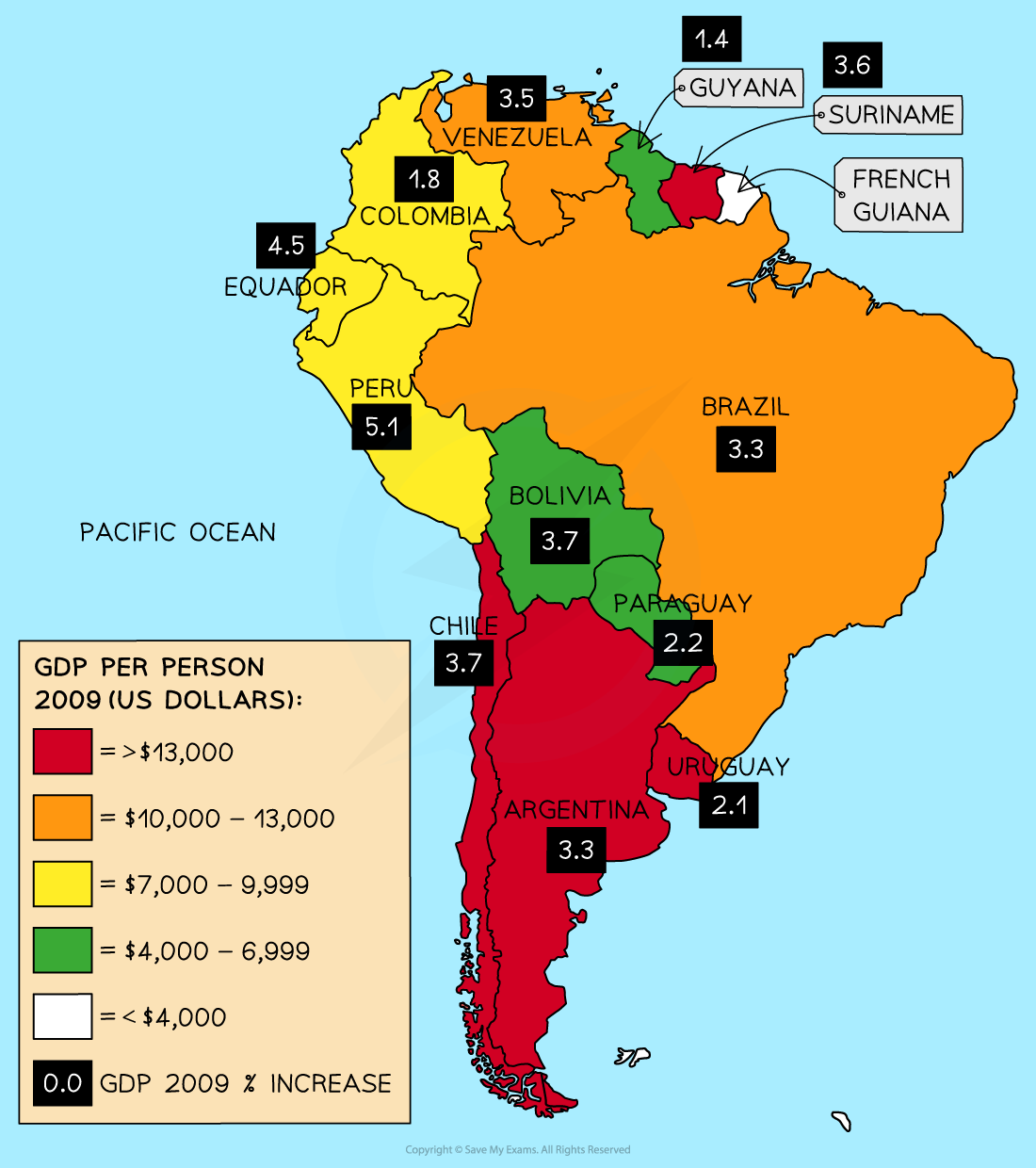Inequalities in Development
Stages of development
- All countries move through the different stages of development
- The UN identifies four main stages of development

Stages of Development
The development gap
- The development gap is the difference in levels of development between the least developed and most developed countries in the world
- There are many factors which lead to the differences in development

Factors Affecting Development and Human Welfare
- Physical geography
- Landlocked countries find trade more difficult and so often develop more slowly
- Small countries develop more slowly due to have fewer human and natural resources
- Those countries with extreme climates develop more slowly
- The physical geography also impacts on the natural resources available
- The natural resources are those things provided by the physical environment
| Natural resource | Uses |
| Water | Domestic use, energy |
| Forests | Timber, habitat, rubber, recreation, food, medicines |
| Fossil Fuels | Fuel, energy |
| Soil | Growing crops |
| Rocks | Construction |
| Minerals | Glass, jewellery, money |
| Animals | Food, skins |
- Some countries are able to meet all their needs from the natural resources they have
- Many countries have to import some natural resources that are not available within their borders
- When countries have to import natural resources, this means they do not have security of supply as imports could be affected by war or political issues
- Water, food and energy security are particularly important to support a country's development
- Demography
- The population structure of a country
- The birth and death rates, as well as immigration, affect the available workforce
- Those countries where birth rates have fallen the most, show the highest rates of growth
- Technology
- Can help to increase water, food and energy security
- Mechanisation of farming increases yields and improved land surveying may reveal more energy sources
- Technology can also mean that existing resources are used more efficiently
- Social
- Levels of education affect the skills people have. The more educated a population is the more a country will develop
- Healthcare affects how well people are which affects their ability to work
- Lack of equality can mean that the overall productivity of a country is affected
- Government policies
- The stability and effectiveness of government can have a significant impact on development and human welfare
- Development and human welfare are greatest where there is a democratically elected government
- Corrupt governments do not invest in the country's development or in improving the quality of life for the population
- A government's economic policy affect development and human welfare through:
- Open economy - where foreign investment is encouraged, which generates faster development
- Higher rates of saving and lower spending compared to GDP, results in further development
Differences within countries
- As well as differences between countries there are also differences in development within countries:
- This can be seen in all countries whether they are developed, emerging or developing
- Often development is focused on particular regions
- Inequalities within countries are due to several factors
- Cumulative causation theory is one explanation for regional differences:
- Growth in the core region attracts skilled labour and capital
- Areas in the periphery suffer as skilled labour leaves and investment is focussed on the core
- The gap between the core and the periphery grows
- Eventually the growth of the core region may stimulate growth in the periphery due to the demand for raw materials

Cumulative Causation
- There are three stages of regional inequality:
- Pre-industrial stage - regional differences are at their lowest
- Period of rapid economic growth - increasing regional differences
- Regional economic convergence - where wealth from the core spreads to other parts of the country
Causes of regional inequalities
- Residence - Urban areas generally attract greater levels of investment leading to increased business and incomes:
- There may also be inequality within the urban area
- Ethnicity - Discrimination can result in ethnic groups having income levels significantly below the dominant groups within a country. This reduces the opportunities open to these groups
- Employment - The split between formal and informal employment impacts incomes. Formal jobs usually have higher incomes and greater benefits, such as holidays and sick pay
- Education - Those with higher levels of education usually gain higher paying employment
- Land ownership -Inequalities in land ownership are strongly linked to inequalities in income
Worked example
Study the figure below which shows GDP per capita in South America along with the percentage change in GDP
State one piece of evidence that there is a development gap in South America
[2]
- As this is for two marks, it is important that you use evidence from the source for the second mark
- There is a difference in GDP per capita between countries [1] French Guiana has a GDP per capita of less than US$4000 whereas Suriname has a GDP per capita of over US$13,000 [1]
OR
-
- There is a difference in the percentage increase of GDP per capita [1] Guyana's increase in GDP per capita is only 1.4% whereas Chile's is 3.7% [1]
Exam Tip
- Remember where an exam question asks for one piece of evidence do not give more than that.
- In the case of the worked example, the one piece of evidence is the comparison between two countries.


